By: H.B.G.
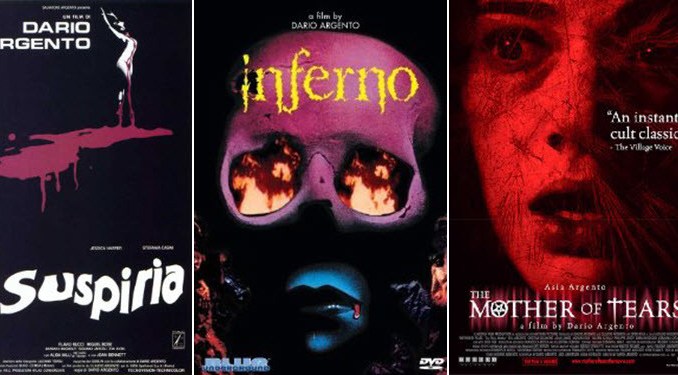 ‘Suspiria’ (1977) is a singular horror movie that has become a classic of modern cinema. It is impossible to overstate the impact this remarkable film – and the unique stylings it’s director Dario Argento – has had upon artists and writers since it’s release 40 years ago. The mysterious name of the film itself serves as a kind of wicked enchantment guaranteed to conjure sighs of awe and twinkles in the eyes of horror film buffs. In this special three part article we will stare long and deep into the dark, searching for The Devil in the Details in the art and mythos of Suspiria and attempt to reveal the weird links between horror film fantasy and genuine occult doctrine. In Part 1 we will introduce The Three Mothers and their origins for those yet unfamiliar, and deepen our understanding of them. Part 2 will connect these femmes fatale to the Triple Goddess of Witchcraft and her necromantic symbols and connections in Suspiria and it’s sequels Inferno and Mother of Tears. Part 3 will round it all out with The Three Mother’s taste for tears, misery and sacrifice.
‘Suspiria’ (1977) is a singular horror movie that has become a classic of modern cinema. It is impossible to overstate the impact this remarkable film – and the unique stylings it’s director Dario Argento – has had upon artists and writers since it’s release 40 years ago. The mysterious name of the film itself serves as a kind of wicked enchantment guaranteed to conjure sighs of awe and twinkles in the eyes of horror film buffs. In this special three part article we will stare long and deep into the dark, searching for The Devil in the Details in the art and mythos of Suspiria and attempt to reveal the weird links between horror film fantasy and genuine occult doctrine. In Part 1 we will introduce The Three Mothers and their origins for those yet unfamiliar, and deepen our understanding of them. Part 2 will connect these femmes fatale to the Triple Goddess of Witchcraft and her necromantic symbols and connections in Suspiria and it’s sequels Inferno and Mother of Tears. Part 3 will round it all out with The Three Mother’s taste for tears, misery and sacrifice.

A symbolically bloody passage leads us over the threshold, towards the inner mysteries of The Three Mothers.
The vitality of the cult art-house status which this extremely original film has achieved is emphasized by the fact that a remake, directed by Italian filmmaker Luca Guadagnino and featuring Dakota Johnson and Tilda Swinton, is due to be released in the not-so-distant future. Hollywood has been grinding out plenty of horror remakes in recent decades and not all have met with much success. Whether or not the Suspiria remix does any justice to the original film or source material, we can see the Suspiria trilogy (with Inferno (1980) and Mother of Tears (2007)) being elevated to the mythic dimensions of Dracula, Frankenstein and The Mummy in our collective movie-going unconscious.
But Suspiria is unique in the horror canon; instead of treading the well-beaten path of vampires, mad scientists or undead pharaohs, the storytelling of Suspiria constellates about (we hesitate to say ‘narrative focuses on’ – because of it’s surrealistic, dream-like nature): witchcraft and black magic, brutal and prolonged ritual murders perpetrated by dark, unseen forces, and the darker side of the feminine principles of motherhood and sisterhood. On film, this heady brew of elements conjures a hallucinogenic kaleidoscope of ingénues in mysterious buildings overseen by shadowy femme fatales, cryptic warnings whispered about witches, a forbidden book by an alchemist, animals that go berserk, and unhinged violence complimented by the inevitably mounting supernatural mayhem.
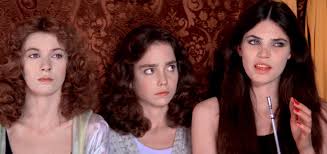
“Names which begin with the letter S… are the names of snakes!” Suspiria!
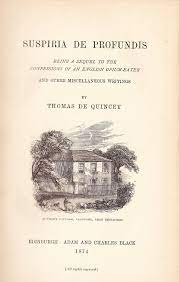 Suspiria‘s origins arise like an intoxicating vapor from the Chinese puzzle-box-like literary works of Romantic Era, British essayist Thomas De Quincey. His best known work: Confessions of an English Opium Eater, inaugurated the tradition of addiction literature in the West when it first appeared in 1822. Later he composed Suspiria de Profundis translated as “Sighs from the Depths,” which was first published in fragmentary form in 1845, from which the title for the film Suspiria derives. The work is a collection of short essays in psychological fantasy — what De Quincey himself called “impassioned prose,” (now termed prose poetry). The essays of the Suspiria “are among the finest examples of De Quincey’s or anyone else’s English style.”
Suspiria‘s origins arise like an intoxicating vapor from the Chinese puzzle-box-like literary works of Romantic Era, British essayist Thomas De Quincey. His best known work: Confessions of an English Opium Eater, inaugurated the tradition of addiction literature in the West when it first appeared in 1822. Later he composed Suspiria de Profundis translated as “Sighs from the Depths,” which was first published in fragmentary form in 1845, from which the title for the film Suspiria derives. The work is a collection of short essays in psychological fantasy — what De Quincey himself called “impassioned prose,” (now termed prose poetry). The essays of the Suspiria “are among the finest examples of De Quincey’s or anyone else’s English style.”
“Some critics consider De Quincey’s Suspiria de Profundis the supreme prose fantasy of English literature.”

“Secret flowers?” Shouldn’t they be opium poppies?
De Quincey conceived of the collection as a sequel to his masterwork, Confessions of an English Opium-Eater. Like that work, the pieces in Suspiria de Profundis are rooted in the visionary experiences of the author’s opium addiction. The Suspiria of De Quincey, when taken all together, are a touchingly poignant and beautifully melancholic excursion into the experiential depths of the sorrows and afflictions of the human heart. He was an extremely sensitive man who suffered deeply from the trials of life, including the premature childhood death of a beloved older sister, and his own son, as may be read in his work. A listing of the titles of the pieces in De Quincey’s Suspiria de Profundis will give some indication as to it’s themes (feel free to skip down to The Three Mothers):
- Dreaming — the introduction to the whole.
- The Palimpsest of the Human Brain — a meditation upon the deeper layers of human consciousness and memory.
- Levana and Our Ladies of Sorrow — beginning with a discussion of Levana, the ancient Roman goddess of childbirth, De Quincey imagines three companions for her: Mater Lachrymarum, Our Lady of Tears; Mater Suspiriorum, Our Lady of Sighs; and Mater Tenebrarum, Our Lady of Darkness.
- The Apparition of the Brocken — on an optical illusion associated with a German mountaintop where dark pagan rites were once practiced.
- Savannah-la-Mar — a threnody on a sunken city, inspired by the 1692 earthquake that sank Port Royal in Jamaica; beginning, “God smote Savannah-la-Mar….”
- Vision of Life — “The horror of life mixed…with the heavenly sweetness of life….”
- Memorial Suspiria — looking forwards and backwards on life’s miseries; foreshadowing and anticipation.
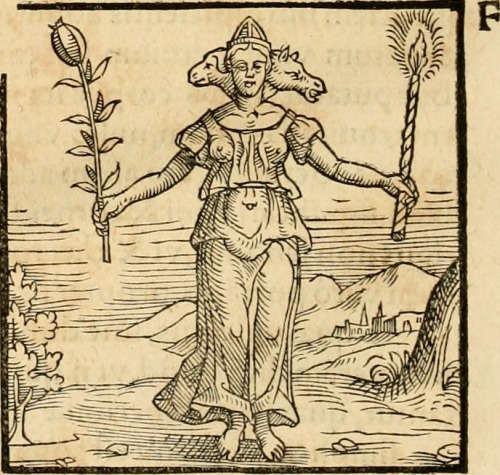
Hekate Triformis, Three-formed Hecate, (with dog and mare heads), offers us an opium seed pod to help illuminate our darkness.
When the collection was reprinted in the collected works in the 1850s, another short essay was added: The Daughter of Lebanon, a parable of grief and transcendence.
The four pieces that first appeared posthumously in 1891 are:
- Solitude of Childhood — “Fever and delirium,” “sick desire,” and the Erl-King’s daughter.
- The Dark Interpreter — he was a looming shadow in the author’s opium reveries. (Reminds us of Dexter Morgan’s “Dark Passenger” from the cable drama series Dexter).
- The Princess that lost a Single Seed of a Pomegranate — echoes upon echoes from an Arabian Nights tale.
- Who is this Woman that beckoneth and warneth me from the Place where she is, and in whose Eyes is Woeful remembrance? I guess who she is — “memorials of a love that has departed, has been — the record of a sorrow that is….”
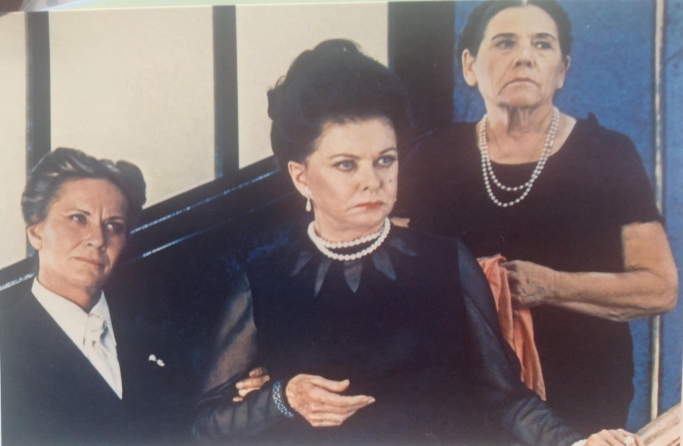
The Ladies of the Academy Suspiria, 1977
The Three Mothers

Of all of the pieces in the Suspiria, Levana and Our Ladies of Sorrow is arguably the most widely anthologized, the best known, and the most admired. “The whole of this vision is clothed in a prose so stately, intense, and musical that it has been regarded by some.. “as the supreme achievement of De Quincey’s genius, the most original thing he ever wrote.” Before the word “archetype” even existed, De Quincey successfully expressed “the mighty abstractions that incarnate themselves in all individual sufferings of man’s heart; …to have these abstractions presented as impersonations, that is, as clothed with human attributes of life, and with functions pointing to flesh.”
It is also at the the black heart of Dario Argento’s cinematic horror masterpiece, as it is here in De Quincey’s Suspiria that we discover the origins of The Three Mothers as fateful companions to the Roman Goddess Levana, thought to oversee childbirth as well as the raising and tutelage of children. By the education of Levana is meant – “not the poor machinery that moves by spelling books and grammars, but that mighty system of central forces hidden in the deep bosom of human life, which by passion, by strife, by temptation, by the energies of resistance, works for ever upon children – resting not day or night,…” Each of these dark goddesses is assigned a specific office; under their dreadful auspices they oversee human misery and sorrow through the powers of sighs, tears and darkness. It will become apparent that Argento took artistic liberties with certain characteristics De Quincey had assigned to each of The Three Mothers as they appear in the films.
The Three Mothers are named and described by De Quincey as:
Mater Lachrymarum – Mother of Tears: Because she is the first-born of her house, and has the widest empire, she is Honored with the title Madonna. “She it is that night and day raves and moans, calling for vanished faces.” And, “She it was that stood in Bethlehem on the night when Herod’s sword swept its nurseries of Innocents, and the little feet were stiffened forever…” And, “Her eyes are sweet and subtle, wild and sleepy by turns; oftentimes rising to the clouds; oftentimes challenging the heavens. She wears a diadem round her head.” And, …“she could go abroad upon the winds, when she heard the sobbing of litanies or the thundering of (funereal) organs…”.

Ania Pieroni appears as Mater Lachrymarum in Inferno, 1980. The oldest sister according to De Quincey.

Our Lady of Sorrows
“She moves with uncertain steps, fast or slow, but still with tragic grace.” Oftentimes she is stormy and frantic; raging against highest heaven and demanding back her darlings. She carries keys “which open every cottage and every palace.” “By the power of her keys it is that Our Lady of Tears glides a ghostly intruder into the chambers of sleepless men, sleepless women, sleepless children” around the world.
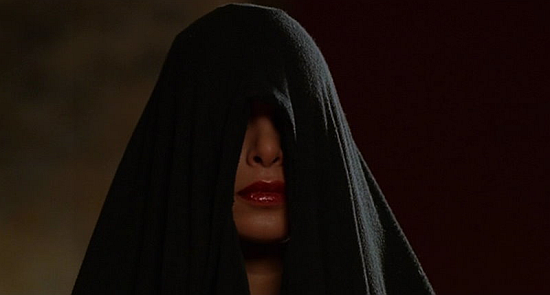
Moran Atias as Mater Lachrymarum. The Mother of Tears, 2007.
Mater Suspiriorum – Mother of Sighs: “She never scales the clouds, nor walks upon the winds.” With drooping head on which sits a dilapidated turban, this humble Lady of the Hopeless “never clamors, never defies.” “And her eyes, if they were ever seen, would be neither sweet nor subtle; …they would be filled with perishing dreams, and with wrecks of forgotten delirium. But she raises not her eyes.” her head droops forever… fastened on the dust. “She weeps not. She groans not. But she sighs inaudibly at intervals.” And, “Hers is the meekness that belongs to the hopeless. Murmur she may, but it is in her sleep. Whisper she may, but it is to herself in the twilight. Mutter she does at times, but it is in solitary places that are desolate as she is desolate, in ruined cities, and when the sun has gone down to his rest. This sister is the visitor of the Pariah…”
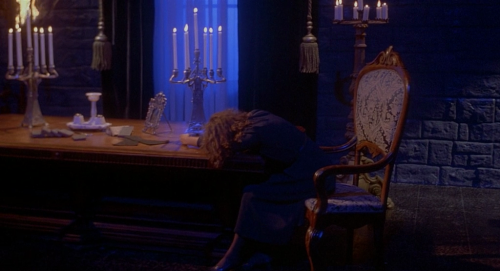
With drooping head, Veronica Lazar as Mater Tenebrarum in Inferno, 1980; appears rather Mater Suspiriorum-ish.
“She also carries a key; but she needs it little. For her kingdom is chiefly amongst the tents of Shem, and the houseless vagrant of every clime.” She sits amongst the pariahs: with the baffled penitent criminal whose name and condition has been forgotten as he languishes in prison, with every slave bound to a caste system, with the disgraced, the betrayed and all outcasts of society, and with the lonely hearts whose fire of younger years has burned away until it is now a solitary candle that gutters on an unseen ledge.
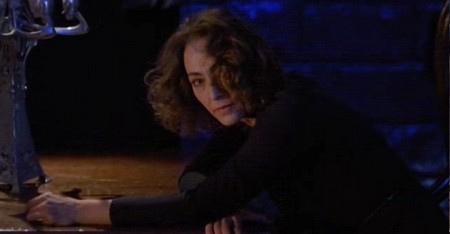
Veronica Lazar as Mater Tenebrarum in Inferno, 1980.
and Mater Tenebrarum – Mother of Darkness: Is the youngest, cruelest and most frightening of the three. We are cautioned to whisper whilst we talk of her! “Her kingdom is not large, or else no flesh should live; but within that kingdom all power is hers. “Her head, turreted like that of Cybèle, rises almost beyond the reach of sight. She droops not; and her eyes rising so high might be hidden by distance. But, being what they are, they cannot be hidden; through the treble veil of crape which she wears, the fierce light of a blazing misery, that rests not for matins or for vespers, for noon of day or noon of night, for ebbing or for flowing tide, may be read from the very ground. She is the defier of God. She also is the mother of lunacies, and the suggestress of suicides. Deep lie the roots of her power; but narrow is the nation that she rules. For she can approach only those in whom a profound nature has been upheaved by central convulsions; in whom the heart trembles and the brain rocks under conspiracies of tempest from without and tempest from within.” And, “…this youngest sister moves with incalculable motions, bounding, and with tiger’s leaps. She carries no key; for… she storms all doors at which she is permitted to enter at all.”

Helena Markos, aka Mater Suspiriorum, is destroyed by Suzy (Jessica Harper) in 1977’s Suspiria.
Occult Horror Geek Purport:
The idea in De Quincey’s dream vision being that the sorrows and afflictions which so work their adversities and “fearful truths” upon his own heart and mind – but by extension we may make this a universal truth as affecting the hearts and minds of us all as children, forming and molding us into mature adults until our hearts are fully aquatinted with the miseries of human existence – these conditions (sighs, tears, and darkness) are a commission from God to these archetypal, female spirits or deities to plague the human heart until they have unfolded the capacities of the spirit.

This is an intriguing concept though not entirely new or unique. The idea of suffering as a motivator leading towards atonement or some kind of spiritual fulfillment is an ancient one and widely recognized, in varying degrees, amongst all religions. Here we may note Buddhism in general, and in particular the Catholic Cult of Mary as the Mother of Sorrows, some devotional goddess cults in India (Kali and similar goddesses), as well as Santa Muerte and the Aztec goddesses Coatlicue and Tlazolteotl, to name just a few.

Santa Muerte
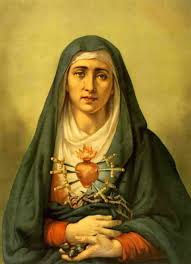
Our Lady of Sorrows clutches the crown of thorns to her pierced sacred heart.
De Quincey’s dream vision being that the sorrows and afflictions which so work their adversities and “fearful truths” upon the heart and mind… are a commission from God to these female spirits, or deities, to plague the human heart until they have unfolded the capacities of the spirit.
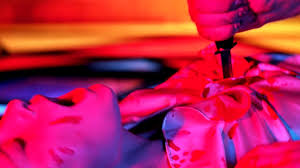
A brutal piercing of the heart in Suspiria.
Early on in Suspiria, the film presents a graphic display of a murder – a kind of atrocious plaguing of the human heart, a raging cenobitic (in the Hellraiser sense) opening up, or unfolding of, the capacities for suffering of the human spirit. Perhaps not exactly what De Quincey had in mind, but the visceral poetry does not escape us. In that first horrific murder scene, the murderer uses a dagger and cord which have significance as will be seen when we explore Hecate – the triple-formed Goddess of Witches – and her symbols in Argento’s Three Mothers Trilogy… in Part 2.
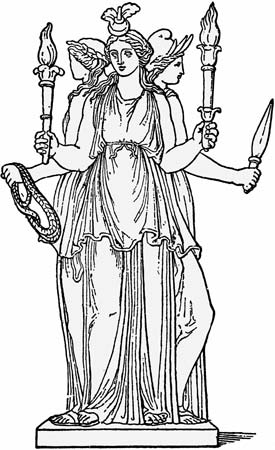
Hecate Triformis
